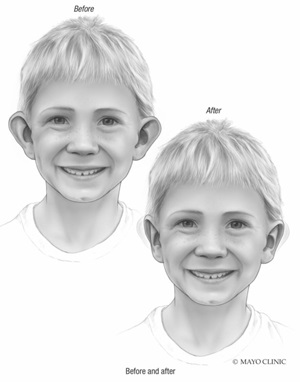Feeling like you're all ears?

The expression "I'm all ears" typically means you're ready to listen to what someone has to tell you. This expression, however, takes on a different meaning if you have prominent or forward-facing ears. You also may feel like you're "all ears."
Having ears that are oversized in proportion to the size of your head or that stick out far from your head can cause embarrassment and distress, which can lead to low self-esteem and lack of self-confidence.
Fortunately, a cosmetic procedure called otoplasty can change ear shape and position. Otoplasty can help restore self-confidence and make you comfortable in your own skin.
People usually have otoplasty performed on both ears to ensure symmetry. A surgeon can do the procedure once ears have reached full size, usually after age 5. The procedure does not change the location of your ears, and it does not affect your ability to hear.
People also may consider otoplasty if their ears are misshapen since birth or due to an injury. For babies born with ear-shape problems or prominent ears, splinting or molding may correct these issues. These techniques should be started by 2 weeks of age and last for an average of four to six weeks.
Preparing for otoplasty
Your care team will review your medical history, including current and past medical conditions and any history of ear infections. Your surgeon will examine the ear's placement, size, shape and symmetry to determine your treatment options. Discuss your expectations for what you'd like your ears to look like after the procedure with your care team. Review the risks of otoplasty, including infection, scarring, asymmetry and overcorrection.
During otoplasty
Depending on the technique used during otoplasty, the surgeon may make incisions on the backs of the ears or within the ear's inner creases. Once the incisions are made, the surgeon can remove excess cartilage and skin, and fold the remaining cartilage into the designated position and secure it with internal stitches. The surgeon will use additional stitches to close the incisions, and the ears will be covered in bandages for protection and support.
The procedure usually takes about two to three hours.

After otoplasty
After otoplasty, your ears will be covered with bandages, and you likely will feel some soreness and itching. You may be advised to take pain medication if there is a need to reduce discomfort. Your healthcare team will remove the bandages a few days after the procedure. Your ears may be swollen or red for a short period, but you will notice the change in the appearance of your ears immediately. The surgeon may use stitches that dissolve or those a healthcare professional can remove in the clinic.
Your surgeon also will advise you when it's OK to resume daily activities, such as bathing and physical activity.
Patrick Shinners, M.D., is an ear, nose and throat specialist with expertise in head and neck surgery in Eau Claire, Wisconsin.



